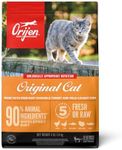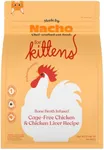Buying Guide for the Best High Protein Cat Foods
Choosing the right high-protein cat food for your feline friend is crucial for their overall health and well-being. Cats are obligate carnivores, which means they require a diet high in protein to thrive. When selecting a high-protein cat food, it's important to consider several key specifications to ensure you're providing the best nutrition for your cat. Understanding these specifications will help you make an informed decision that meets your cat's specific needs.Protein ContentProtein content is the percentage of protein in the cat food. This is important because cats need a high amount of protein for muscle maintenance, energy, and overall health. Look for foods with a protein content of at least 30% for dry food and 10% for wet food. If your cat is very active or a growing kitten, you might want to aim for even higher protein levels. For older or less active cats, a moderate protein level might be sufficient.
Source of ProteinThe source of protein in cat food can vary, including options like chicken, fish, beef, or plant-based proteins. Animal-based proteins are generally more complete and digestible for cats. Look for foods that list a specific meat source as the first ingredient, such as 'chicken' or 'salmon,' rather than vague terms like 'meat by-products.' If your cat has allergies or sensitivities, you may need to choose a food with a novel protein source, such as duck or venison.
Grain-Free vs. Grain-InclusiveGrain-free cat foods do not contain grains like corn, wheat, or soy, which some cats may be sensitive to. Grain-inclusive foods, on the other hand, include these grains as part of their carbohydrate content. If your cat has a grain allergy or sensitivity, a grain-free option might be best. However, if your cat tolerates grains well, grain-inclusive foods can be a good source of energy and fiber. Always check with your vet if you're unsure about your cat's dietary needs.
Moisture ContentMoisture content refers to the amount of water in the cat food. Wet cat foods have higher moisture content, which can help keep your cat hydrated and support urinary health. Dry cat foods have lower moisture content but are more convenient to store and serve. If your cat doesn't drink much water, incorporating wet food into their diet can be beneficial. For cats that drink plenty of water, dry food can be a suitable option.
Additives and PreservativesAdditives and preservatives are used to enhance flavor, texture, and shelf life of cat food. Natural preservatives like vitamin E (mixed tocopherols) and vitamin C (ascorbic acid) are generally safer than artificial ones like BHA, BHT, and ethoxyquin. Look for foods with minimal additives and natural preservatives to ensure your cat is eating a healthier diet. If your cat has sensitivities, avoiding artificial colors, flavors, and preservatives is especially important.
Life Stage and Health ConditionsCat foods are often formulated for specific life stages such as kitten, adult, or senior, as well as for specific health conditions like weight management, urinary health, or hairball control. It's important to choose a food that matches your cat's life stage and any health conditions they may have. For example, kittens need more protein and fat for growth, while senior cats may need fewer calories and more joint support. Consult your vet to determine the best food for your cat's specific needs.




















